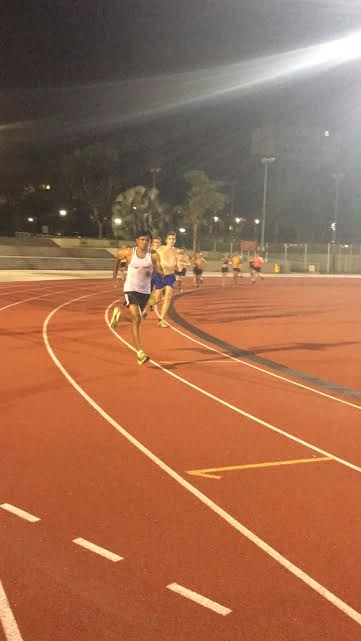If you are keen and have queries, please contact Coach Rameshon at 9100 4369 or you can email him at m.rameshon@gmail.com or swift.rameshon@gmail.com. Please refer to website http://flexifitness.com.sg (for more information on him and his programmes)
By Rameshon
Bsc (Hons) Degree in Physical Education, Loughborough University (1992-1994)
Masters in Education (University of Western Australia, 2005-2008)
Stories That Fascinated Me During My Running Days
Jane Fonda (Left) and Jennifer Lopez (Right) in the Movie
Monster-In-Law
Ego - The cause of a person's downfall. One of the five vices.
Stories From the East
In India, there was an incident where two ladies in the house were arguing and quarrelling. One of them was the mother-in-law and the other was the daughter-in-law. The argument was getting worse and worse to the point that there was shouting and screaming, except for the throwing of pots and pans.
Suddenly, to save the situation, fortunately, a beggar was standing outside the door asking for alms. At first, he did not see anyone coming. When the daughter-in-law heard the beggar, she immediately attended to this by going to the front door and opened the door promptly. Seeing this, The mother-in-law also made her move towards the door. Before the mother-in-law could attend to the beggar, the daughter-in-law started asking the person what he exactly wants.
The beggar was very happy to hear this and told the daughter-in-law that he wants some rice. The daughter-in-law told the beggar that she does not have any rice in a stern and firm manner. Hearing this, the beggar started to leave the place at once with disappointment. He was walking swiftly for some 50metres from the house and then all of a sudden someone else called him back to the house again. It was the mother-in-law. The beggar saw hope and he was smiling. He thought that the mother-in-law was kind enough to not turn him away. Seeing this, the mother-in-law spoke kindly and told the beggar to wait while she had to go inside. After a period of 5mins, the beggar lost all patience and started calling out loud to the mother-in-law to come and attend to him. Finally, the mother-in-law came out of the house empty-handed.
When she saw the beggar, she told him to go. The beggar got mad at this. He asked the mother-in-law the intention of stopping him from going to other places for food. To this, the mother-in-law told that she is the real decision-maker of the house and not the daughter-in-law. She told, " Who is she to make a decision?" Then, the beggar realised that actually he only wasted his time by coming back to the house. He left the place finally with a bigger disappointment.
Ego - An Analysis
When the daughter-in-law had told him a no to the beggar for food, the mother-in-law should have just not bothered to call the poor beggar back. The poor beggar had actually wasted his time for other person's whim. I find that the ego of the mother-in-law is unnecessary as the answer was already given by the daughter-in-law. It only wasted the beggar's time, that's all. The result was the same - no food. This is the ego. A fall in a man comes when ego and pride appear first. Ego appears before a man's fall. Ego is being not natural and egolessness is our natural self. Egolessness leads to fearlessness and there will be no nervousness in a person.
Applicable to Running
If you take your time as the opponent, there is no ego. You are in fact challenging against your own self. Hence, since it is your own self, one will not feel stressed to perform. When you know that the enemy or opponent is you yourself, we tend to go for goals that we can achieve easily. You are not afraid of your own self.
If you take your opponent as your target, you may not have a peaceful sleep the night before. The target may not be gradual, systematic and progressive. It could be something that cannot be achieved. Furthermore, when one loses, the ego is affected and depression may set in. In the case of losing to your own timing, one will strive to achieve the time one has done or a little bit better. This will give one less stress. The only person you are going to lose is oneself. Our great runner from Malaysian, M. Ramachandran has done this and had achieved success most of the time, if not every time. Also, I had this form of experience of doing well during a race by concentrating on improving my own time rather than concentrating on winning. Winning will take place by itself automatically. Hence, no nervousness and only fearlessness will set in. The muscles will be relaxed.
It is good to note that the ego is not one's self.
Note:
By Narayanan
Rameshon has taught in Hwa Chong Institution, plus several schools, and Republic Polytechnic as well. He has won many accolades and he was awarded Merit Award for 1991 marathon performance in breaking the national record of Singapore, at that time. He has made 22 male athletes to do marathon in sub-3hrs. He has made 7 female runners to do sub-4 hours for marathon, as well. He was inducted to the ‘Roll of Honour’ by the then College of Physical Education, organised by Singapore Olympic Academy, in 1998, for breaking the National record repeatedly 4 times, till he did 2hr 24min 22sec).
He also has a Coaching group and he trains them on Tuesdays and Thursdays, 7pm at Botanic Gardens. Those interested can call him at 91004369 for coaching assistance, to improve performance. There is also personal training that he does for many in a week. You can e-mail him at swift.rameshon@gmail.com.















